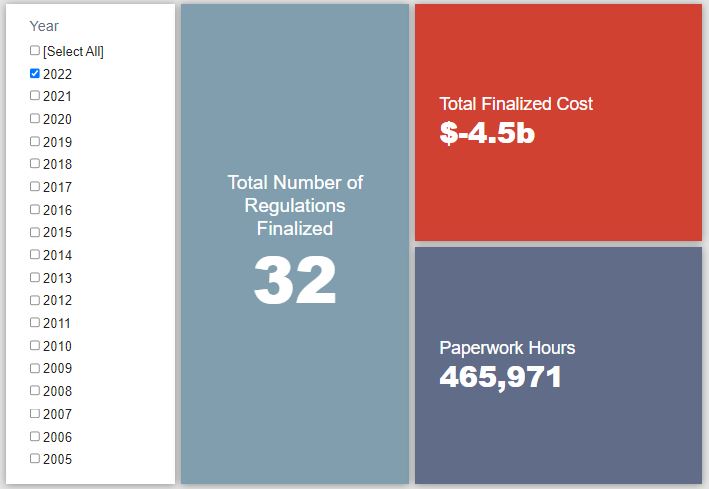Week in Regulation
February 22, 2022
A Very SEC-Driven Week
The middle of February 2022 provided little of note on the regulatory front. There were seven rulemakings with some measurable economic impact, but only one crossed the $100 million cost threshold. The most identifiable trend was a trio of proposed rules from the Securities and Exchange Commission (SEC) that provided the vast majority of the week’s overall economic effects. Across all rulemakings, agencies published $268.9 million in total net costs and added 974,842 annual paperwork burden hours.
REGULATORY TOPLINES
- Proposed Rules: 40
- Final Rules: 64
- 2022 Total Pages: 9,408
- 2022 Final Rule Costs: -$4.5 billion
- 2022 Proposed Rule Costs: $447.5 million
NOTABLE REGULATORY ACTIONS
This past week, the regulatory spotlight shone brightest on the SEC. Covering issues ranging from insider trading to share repurchases to investment adviser reporting requirements, the three SEC proposed rules together accounted for roughly 90 percent of the week’s overall cost total and virtually all of its paperwork total. The most significant of the three, the proposal regarding insider trading, seeks to update a series of disclosure requirements for various relevant actors that could be involved in an insider trading scheme. The SEC estimates that these changes will increase the annual administrative burden by 747,445 hours of paperwork with nearly $57 million in commensurate costs.
TRACKING THE ADMINISTRATIONS
As we have already seen from executive orders and memos, the Biden Administration will surely provide plenty of contrasts with the Trump Administration on the regulatory front. And while there is a general expectation that the new administration will seek to broadly restore Obama-esque regulatory actions, there will also be areas where it charts its own course. Since the American Action Forum (AAF) RegRodeo data extend back to 2005, it is possible to provide weekly updates on how the top-level trends of President Biden’s regulatory record track with those of his two most recent predecessors. The following table provides the cumulative totals of final rules containing some quantified economic impact from each administration through this point in their respective terms.
![]()
With only two relatively modest final rules last week, the Biden Administration’s to-date regulatory totals remained largely at a standstill. Across all three administrations, in fact, there were no particularly major shifts. Perhaps the most pronounced change came in the Trump paperwork total. Thanks primarily to a Department of Education rule that delayed the implementation of an Obama-era regulation regarding student loans, the Trump Administration saw its paperwork total fall by more than 250,000 annual paperwork burden hours.
THIS WEEK’S REGULATORY PICTURE
This week, forthcoming energy efficiency regulations for hot tubs.

On February 16, the Department of Energy (DOE) published a notice in the Federal Register that it is proposing to formally determine that portable electric spas are a “covered product” under a law that authorizes the agency to set energy efficiency standards.
The Energy Policy and Conservation Act grants DOE the authority to add certain non-vehicle products to its list of covered products if the agency finds that it serves the intent of the law and if the product has an annual per-household-energy use of 100 kilowatt hours (kWh) or more. DOE argues that portable electric spas, which are defined as “hot tubs or spas that are intended for the immersion of people in heated, temperature-controlled water that is circulated in a closed system,” fit the criteria to be covered. The notice would cover standard spas, exercise spas, combination spas, and inflatable spas.
DOE decided to cover hot tubs at the behest of the Pool and Hot Tub Alliance (PHTA), an industry group. PHTA sought coverage of their products because it would qualify the products for certain energy efficient tax benefits and, more important, prevent a patchwork of state laws setting various standards.
Separate DOE and PHTA research estimate the average hot tub uses between 1,567 and 1,699 kWh per year. Combined with the fact that about 250,000 hot tubs are shipped every year, DOE determined it has the justification to bring the spas under their energy efficiency program.
According to DOE, the determination would not establish test procedures or energy conservation standards but would allow the agency to do so in the future if warranted. As such, there are no estimated economic costs associated with the proposal.
TOTAL BURDENS
Since January 1, the federal government has published $4.0 billion in total net cost savings (with $4.5 billion in new cost savings from finalized rules) and 3.2 million hours of net annual paperwork burden increases (with 465,971 hours in increases from final rules).












